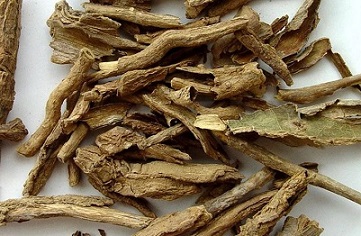Mycoplasma Pneumoniae: Kukoamine A From Cortex Lycii Radices Improves Infections By Regulating miR-222-3p/Superoxide Dismutase 2
Nikhil Prasad Fact checked by:Thailand Medical News Team Dec 06, 2023 1 year, 11 months, 3 weeks, 3 days, 15 hours, 26 minutes ago
Mycoplasma Pneumoniae pneumonia (MPP) remains a prevalent respiratory disease affecting pediatric patients, with the causative agent,
Mycoplasma Pneumoniae, accounting for a significant portion of community-acquired pneumonia cases. Despite its common occurrence, the intricacies of MPP's etiology and pathogenesis pose challenges for targeted therapeutic development. The interplay of host immune reactions and dysregulated proinflammatory cytokines, such as IL-6 and TNF-α, contributes to MPP severity. Traditional antibiotic treatments are common, but the promising potential of traditional Chinese medicine (TCM), particularly the Qingfei Tongluo formula (QTF) containing Kukoamine A (KuA), warrants exploration.
 Cortex Lycii Radices
Host-Pathogen Interplay: A Focus on Oxidative Stress
Cortex Lycii Radices
Host-Pathogen Interplay: A Focus on Oxidative Stress
Exotoxins and exotoxin-like substances produced by M. pneumoniae play a pivotal role in inducing toxin-like effects. M. pneumoniae infiltrates bronchial mucous membranes, releasing hydrogen peroxide and causing damage to bronchial epithelial cells. Superoxide dismutase 2 (SOD2), a crucial antioxidant enzyme controlling reactive oxygen species (ROS) production, plays a central role in mitigating oxidative stress. However, the dysregulation of these components contributes to cellular damage and disruption of essential biological processes.
MicroRNA Landscape in MPP: Spotlight on miR-222-3p
Noncoding RNAs, specifically microRNAs (miRNAs), have emerged as vital regulators of various physiological processes. Recent studies identify miR-222-3p as a potential diagnostic and prognostic marker for MPP. This section explores the landscape of miR-222-3p in MPP pathogenesis and its correlation with proinflammatory cytokines, setting the stage for understanding its role in inducing inflammation.
Exosome-Mediated Communication: Cellular Crosstalk in MPP
Exosomes, lipid bilayer-enclosed extracellular vesicles, have gained prominence as mediators of intercellular communication. This section delves into the role of exosomes in MPP, specifically their influence on human alveolar basal epithelial cells (HABECs). The study successfully isolates exosomes from MPP patient serum, highlighting their purity and uptake by A549 cells. The subsequent exposition of A549 cells to MPP serum exosomes triggers a robust inflammatory response, showcasing the potential impact of exosome-mediated communication in MPP pathogenesis.
Kukoamine A Intervention: Dose-Dependent Modulation of Inflammation
The study introduces Kukoamine A (KuA), a spermine alkaloid from Cortex Lycii radices and a major component of QTF. As A549 cells are exposed to MPP serum exosomes, KuA demonstrates a dose-dependent ability to reverse inflammatory effects, emphasizing its potential as a therapeutic intervention. The study further elucidates KuA's role in mitigating oxidative stress conditions induced by MPP, expanding our understanding of its pharmacological properties.
gt;
miR-222-3p/SOD2 Axis: Molecular Mechanisms Unveiled
Molecular mechanisms underlying the miR-222-3p-induced inhibition of SOD2 activity are dissected in this section. The study reveals that miR-222-3p negatively regulates SOD2 through interaction with its 3'-UTR, providing crucial insights into the regulatory network governing inflammation in MPP. The overexpression of SOD2 counters proinflammatory effects induced by miR-222-3p, reinforcing the significance of this axis in MPP pathogenesis.
KuA's Precision Targeting: Attenuation of Inflammation
The study examines KuA's specific intervention in the miR-222-3p/SOD2 axis. KuA efficiently reverses MPP serum exosome-mediated inhibition of SOD2, diminishes nuclear NF-κB activity, and partially mitigates inflammatory effects induced by miR-222-3p mimics. Notably, KuA's specificity in targeting the miR-222-3p/SOD2 axis is highlighted, providing a promising avenue for therapeutic development.
Conclusion: Integrating Traditional Medicine for Future Respiratory Health
In conclusion, this comprehensive study unravels the intricate molecular mechanisms underpinning MPP and highlights the therapeutic potential of KuA from Cortex Lycii radices. The miR-222-3p/SOD2 axis emerges as a central player in MPP-induced inflammation, paving the way for targeted therapeutic interventions. KuA's efficacy in mitigating inflammatory responses positions it as a potential candidate for MPP treatment. As we unravel the complexities of MPP, the integration of traditional medicine, such as KuA from TCM, holds significant promise in shaping the future landscape of respiratory disease management. The study not only deepens our understanding of MPP but also opens avenues for personalized and effective treatment strategies, reducing reliance on antibiotics and incorporating TCM approaches for improved patient outcomes.
The study findings were published in the peer reviewed journal: BioMed Research International.
https://www.hindawi.com/journals/bmri/2022/2064013/
For the latest on
Mycoplasma Pneumoniae, keep on logging to Thailand Medical News.
